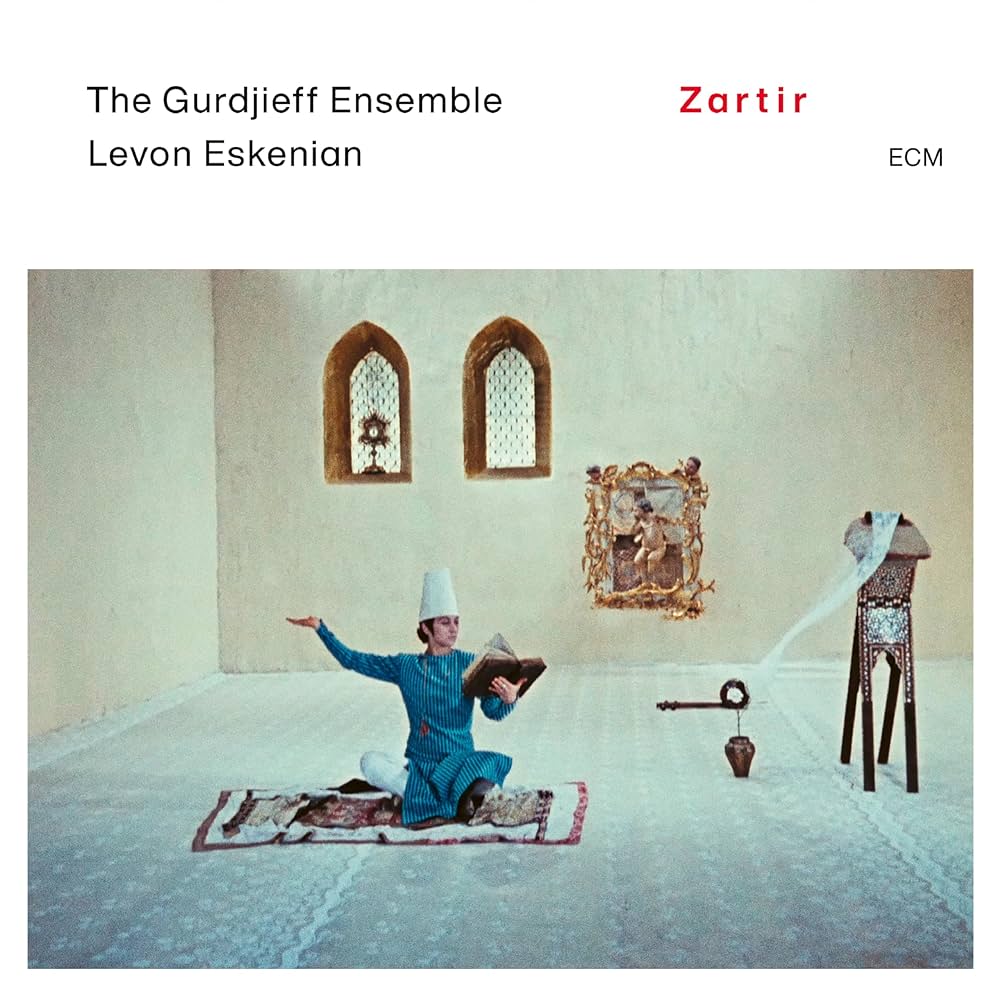Het Gurdjieff Ensemble biedt op hun nieuwe album Zartir een fraaie collectie werken van Armeense componisten, waaronder Georges I. Gurdjieff en Sayat-Nova.
English version below
De Armeniër Georges I. Gurdjeiff (ca 1877-1949) was naast filosoof, spiritueel leraar, danser ook componist. De muziek die hij onderweg hoorde en de stukken die hijzelf componeerde, werden door de Oekraïense componist Thomas de Hartmann, met wie Gurdjeiff samenwerkte, op muziek gezet. Enkele van deze werken heeft dirigent Levon Eskenian gearrangeerd voor zijn Gurdjieff Ensemble. Een 12-koppig ensemble waarvan eind 2023 het schitterende Zartir werd uitgebracht. Op dit derde album staan naast werken van Gurdjieff, ook composities van de eveneens Armeense componisten Ashugh Jivani (1846-1909), Sayat-Nova (1712-1795) en Baghdasar Dbir (1683-1768).
Het instrumentarium van het Gurdjieff Ensemble bestaat uit santur (snaarinstrument), ûd (Arabische luit), tar (snaarinstrument), kamanche (soort viool), percussie en blul (soort fluit) en duduk. De duduk is een dubbelriet-instrument dat nog het meest lijkt op de westerse hobo, maar dan met breder mondstuk en een fluweel-zacht timbre. De duduk is het nationale Armeense instrument, gemaakt van perzikhout en wordt zowel gebruikt voor melodie als voor de drone. Een langklinkende toon die door circulair breathing blijft doorklinken. Een blaas-techniek die ook wordt gebruikt bij het bespelen van de Australische didgeridoo. Deze doorklinkende toon heeft een licht bezwerende werking en komen we bijvoorbeeld tegen in de stukken Introduction and Funeral Ceremony en Kankaravar Enker.
De veelal instrumentale arrangementen op Zartir zijn transparant en ademen rust en contemplatie uit. In verschillende bezettingen wordt uitmuntend gespeeld, waarin je wordt meegevoerd naar het verleden, met eeuwenoud instrumentarium en toonsoort (voor de liefhebber: mineur met een frygische 2). De vloeiende thema’s van de duduk of de blul (fluit) worden met twinkelende tremolo’s op de kanun en de santir ondersteund en aangevuld met percussie instrumenten zoals tombak (trommel), dap (grote handtrom met belletjes), bellen en triangel. In enkele stukken horen we de warme vocalen van Vladimir Papikyan. In Kankaravar Enker (met duduk-drone en gecomponeerd door Jivani) zingt hij over Een getalenteerde vriend, terwijl het lied Dard Mi Ani (van Sayat-Nova) handelt over zorgeloosheid. Het album sluit af met The Great Prayer van Gurdjieff. Een sacraal werk waarin naast het Gurdjieff Ensemble ook de subtiele fonetische zang van het Nationale Kamerkoor van Armenië (onder leiding van Robert Mikeyan) te horen is. Deze vocalen worden unisono ondersteund door kanun, blul en duduk waardoor ze meer diepgang krijgen en waarmee Zartir adembenemend wordt afgesloten.
Concert Gurdjieff Ensemble BOZAR Brussel 26 jan. 2024
Concert Gurdjieff Ensemble Concergebouw Amsterdam 28 jan. 2024
English version
On the new album Zartir, the Gurdjieff Ensemble offers a beautiful collection of works by Armenian composers including Georges I. Gurdjieff and Sayat-Nova.
Georges I. Gurdjeiff (ca 1877-1949) was not only a Armenian philosopher, spiritual teacher, dancer, but also a composer. The music he heard along the way and the pieces he composed himself were set to music by the Ukrainian composer Thomas de Hartmann, with whom Gurdjeiff collaborated. Conductor Levon Eskenian has arranged some of these works for his Gurdjieff Ensemble. A 12-piece ensemble of which released the beautiful CD Zartir at the end of 2023. In addition to works by Gurdjieff, this third album also contains compositions by the Armenian composers Ashugh Jivani (1846-1909), Sayat-Nova (1712-1795) and Baghdasar Dbir (1683-1768).
The instruments that are used by the Gurdjieff Ensemble consists of santur (stringed instrument), ûd (Arabic lute), tar (stringed instrument), kamanche (type of violin), percussion and blul (type of flute) and duduk. The duduk is a double reed instrument that most resembles the Western oboe, but with a wider mouthpiece and a velvety-soft timbre. The duduk is the national Armenian instrument, made of peach wood and used for melody as well as for the drone. A long-sounding tone that continues to resonate through circular breathing. A blowing technique that is also used when playing the Australian didgeridoo. This resounding tone has a slightly conjuring effect and we encounter it, for example, in the pieces Introduction and Funeral Ceremony and Kankaravar Enker.
The mostly instrumental arrangements on Zartir are transparent and exude peace and contemplation. The playing is excellent in various settings, in which you are moved to the past, with age-old instruments and keys (for enthusiasts: minor with a Phrygian 2). The flowing themes of the duduk or blul (flute) are supported by twinkling tremolos on the kanun and santir and supplemented with percussion instruments such as tombak (drum), dap (large hand drum with bells), bells and triangle. In some pieces we hear the warm vocals of Vladimir Papikyan. In Kankaravar Enker (with duduk drone and composed by Jivani) he sings about A talented friend, while the song Dard Mi Ani (by Sayat-Nova) is about carefreeness. The album closes with Gurdjieff’s The Great Prayer. A sacred work in which, in addition to the Gurdjieff Ensemble, the subtle phonetic singing of the National Chamber Choir of Armenia (conducted by Robert Mikeyan) can also be heard. These vocals are supported in unison by kanun, blul and duduk, giving the music more depth. A breathtaking closing piece of the splendid music on Zartir.
Concert Gurdjieff Ensemble BOZAR Brussels Jan. 26 2024
Concert Gurdjieff Ensemble Concergebouw Amsterdam Jan. 28 2024
*The Gurdjieff Ensemble: Zartir (ECM Records)
© Mattie Poels.


Geen reacties